Physical Address
304 North Cardinal St.
Dorchester Center, MA 02124
Physical Address
304 North Cardinal St.
Dorchester Center, MA 02124
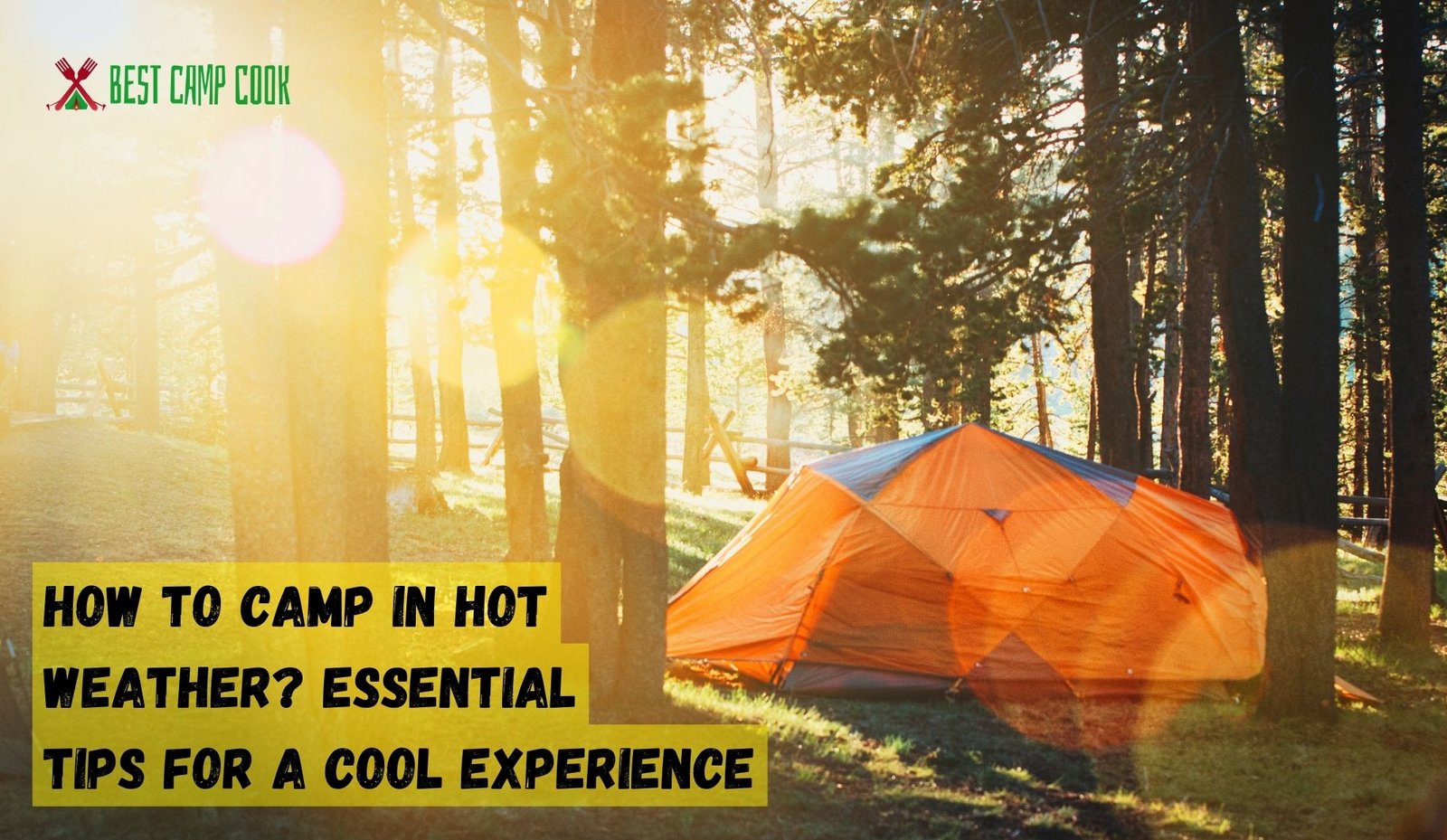
How to camp in hot weather? Get ready to embrace the heat and have an unforgettable outdoor adventure! Camping in hot weather can be a thrilling and rewarding experience if you know the tips and tricks to stay cool and comfortable.
Don’t let the scorching sun deter you from exploring the great outdoors. In this guide, we’ll equip you with practical strategies, essential gear recommendations, and expert advice to make your hot weather camping trip a breeze.
Whether you’re a seasoned camper or a beginner, we’ve got you covered with valuable insights to beat the heat and make the most of your camping adventure. So grab your sunscreen, pack your shades, and let’s dive into the exciting world of camping in hot weather!
Main Summary: How to Camp in Hot Weather?
To camp in hot weather, choose a shaded campsite with ventilation, wear lightweight, breathable clothing, stay hydrated, and use cooling devices like fans or misting devices. Optimize shade with tarps, set up tents strategically for airflow, and plan outdoor activities during cooler hours.
Camping in hot weather can be a challenging yet rewarding experience. With the right strategies and preparations, you can ensure a comfortable and enjoyable outdoor adventure even when the temperatures soar. In this article, we will explore the art of camping in hot weather and provide you with valuable tips to make your trip a breeze.
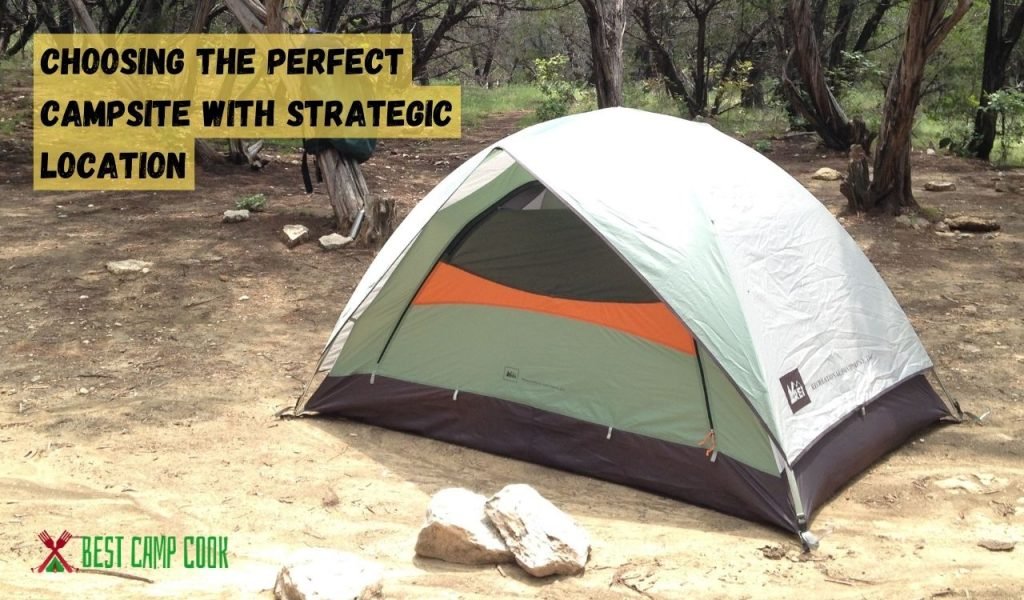
Selecting the ideal campsite is crucial when camping in hot weather. Look for a location that offers ample shade, preferably under trees or near natural formations that can provide relief from the scorching sun. This will help lower the ambient temperature and create a cooler environment for your campsite.
Consider the direction of the prevailing winds. Opting for a spot where a gentle breeze can pass through will aid in ventilation and prevent the air from becoming stagnant. Look for campsites near water bodies such as lakes or rivers. Not only can these provide a refreshing swim, but they also help cool the surrounding area due to the evaporative effect.
When setting up your tent, pay attention to its positioning to optimize airflow. Ensure that the entrance is facing the direction of the prevailing winds, allowing a constant breeze to flow through the tent. This will help maintain a pleasant temperature inside.
Consider using a rainfly or tarp to create additional shade over your tent. This will help reduce the amount of direct sunlight hitting the tent’s surface, keeping the interior cooler. It’s also advisable to set up your tent on higher ground if possible, as hot air tends to rise, and you’ll benefit from the slightly cooler air at higher elevations.

Packing the right gear and supplies is vital when camping in hot weather. Here are some essentials to keep in mind:

Creating a heat-resistant shelter is essential when camping in hot weather. Here are some tips and tricks to help you stay cool and protected:
Choose a tent specifically designed for hot weather camping. Look for tents with adequate ventilation, such as multiple mesh panels or large windows, to promote airflow. Consider a tent with a rainfly that can be partially or completely removed to maximize ventilation during hot days.
Position your tent in a shaded area, away from direct sunlight. If shade is limited, use additional tarps or reflective blankets to create shade around your tent. Avoid placing your tent on surfaces that can absorb and radiate heat, such as bare rocks or asphalt.
Consider using heat-reflective materials to cover your tent or rainfly. These materials help bounce off sunlight and reduce the amount of heat absorbed by your shelter. Reflective blankets, emergency foil blankets, or specialized tent covers made with reflective materials are all effective options.

Staying cool in hot weather is crucial for a comfortable camping experience. Here are some techniques to help manage the temperature:
Drink plenty of water throughout the day to stay hydrated. Dehydration can lead to heat-related illnesses, so it’s important to consume fluids regularly. Pack a water bottle or hydration pack and make it a habit to drink at regular intervals, even if you don’t feel particularly thirsty.
Seek shade during the hottest parts of the day. Plan activities that involve staying under trees, awnings, or other shaded areas. Use umbrellas or portable shade structures to create additional shade at your campsite.
Spending time in cooler areas can significantly reduce your body’s exposure to direct sunlight and help regulate your temperature.
Take advantage of natural cooling techniques. Wet a bandana or towel and place it on your neck or forehead to provide instant relief. Dip your feet in a nearby stream or use a portable misting device to cool down. Utilize handheld fans or battery-operated fans to create airflow around your body.
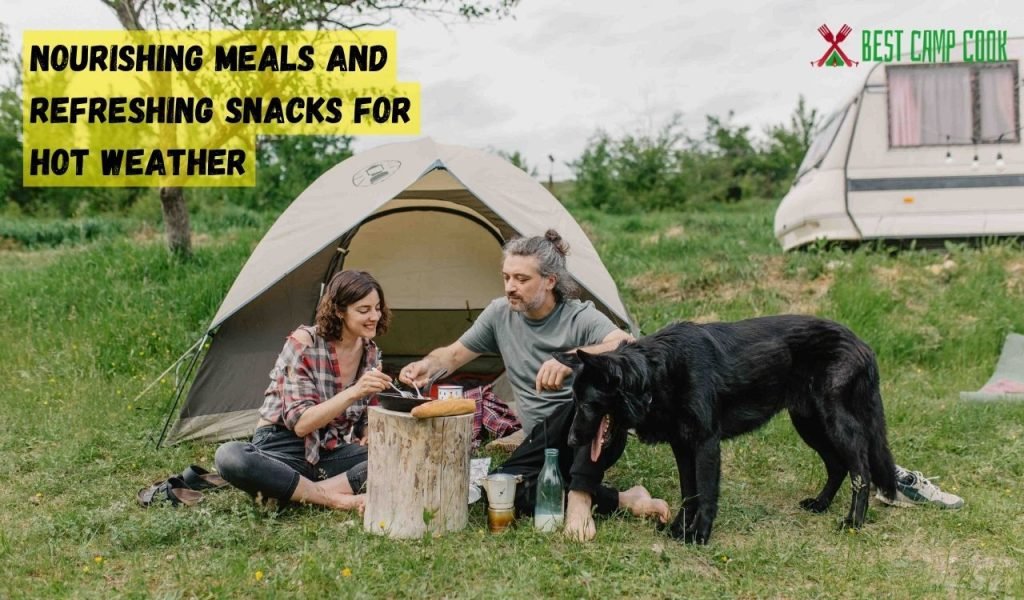
Proper nutrition is crucial when camping in hot weather. Here are some ideas for nourishing meals and refreshing snacks to keep you energized and hydrated:
Incorporate foods with high water content into your meals. Watermelon, cucumbers, oranges, and strawberries are excellent choices. These fruits not only provide hydration but also offer essential vitamins and minerals.
Opt for light and easy-to-digest meals that won’t weigh you down in the heat. Salads with grilled chicken or shrimp, cold pasta salads with fresh vegetables, or wraps with lean protein and crisp veggies are all refreshing options. These meals provide nourishment without feeling heavy on a hot day.
Snack on foods rich in electrolytes to replenish what you lose through sweat. Pack electrolyte drinks, sports gels, or electrolyte-infused snacks like trail mix or energy bars. These snacks help restore essential minerals and maintain proper hydration levels.
Engaging in enjoyable activities is an integral part of any camping trip, even in hot weather. Here are some fun ideas to make the most of your hot weather camping experience:
Take advantage of nearby bodies of water for water-based activities. Go for a refreshing swim, try your hand at paddleboarding or kayaking, or simply relax on a floatation device. These activities not only provide relief from the heat but also add a sense of adventure and fun to your camping trip.
Embark on nature walks and hiking trails during the cooler parts of the day, such as early mornings or evenings. Explore shaded trails, forested areas, or higher altitudes where temperatures may be slightly lower. Enjoy the beauty of nature, observe wildlife, and capture stunning photographs along the way.
Engage in outdoor games and sports that keep you active while having a blast. Set up a volleyball or badminton net, organize a game of frisbee, or challenge your camping companions to a friendly round of horseshoes. These activities promote camaraderie and laughter while allowing you to stay active in a fun-filled environment.
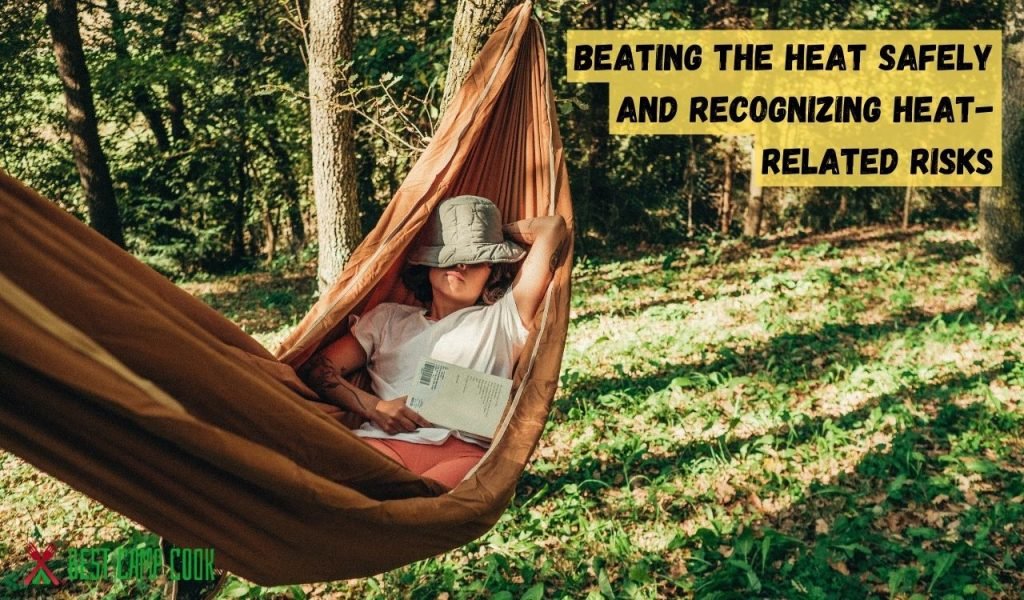
While camping in hot weather, it’s crucial to prioritize your safety and be aware of heat-related risks. Here are some tips to beat the heat safely and recognize potential dangers:
Drink plenty of water and fluids to stay hydrated throughout the day. Avoid caffeinated and sugary beverages as they can contribute to dehydration. Take regular breaks in shaded areas or air-conditioned spaces to cool down and prevent overheating.
Wear lightweight, breathable clothing that covers your skin and provides sun protection. Apply a broad-spectrum sunscreen with a high SPF rating to exposed areas. Don’t forget to wear a wide-brimmed hat, sunglasses, and seek shade whenever possible to minimize direct sun exposure.
Educate yourself about the signs and symptoms of heat-related illnesses such as heat exhaustion and heatstroke. Symptoms may include dizziness, fatigue, headache, rapid heartbeat, nausea, or confusion. If you or anyone in your group experiences these symptoms, move to a cool area, hydrate, and seek medical assistance if necessary.
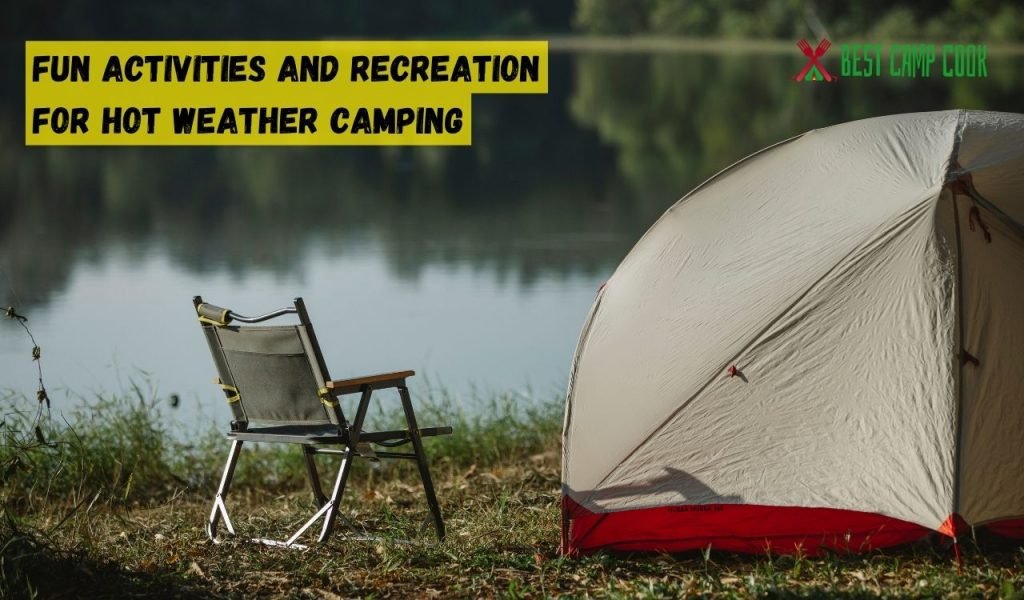
Make your hot weather camping trip a breeze with these expert tips and hacks:
Opt for a tent that offers excellent ventilation and breathability. Look for tents with mesh panels and windows that allow airflow while keeping bugs out. Set up your tent in a shaded area or use a rainfly without covering the mesh sections to enhance air circulation.
Maximize shade at your campsite by using tarps or shade sails. Set them up strategically to block the sun’s direct rays during the hottest parts of the day. This additional shade will help keep your campsite and seating areas cooler and more comfortable.
Consider using cooling devices specifically designed for camping. Portable evaporative coolers or battery-powered fans can provide a refreshing breeze inside your tent or outdoor living spaces. Freeze gallon-sized water jugs and place them in front of fans for a makeshift air conditioning effect.
Choose lightweight, breathable clothing made from moisture-wicking fabrics. Opt for light colors that reflect the sun’s rays instead of absorbing them. Wearing a wide-brimmed hat and sunglasses will provide extra protection from the sun and keep you cooler.
Keep yourself hydrated by drinking plenty of water throughout the day. Bring a reusable water bottle and refill it regularly. Enhance the hydration experience by infusing water with fresh fruits or herbs for added flavor. Pack a cooler with ice-cold beverages and refreshing snacks to enjoy during breaks.
Hot weather camping may pose its challenges, but with the right mindset and preparation, you can have an incredible outdoor experience. Here’s how to conquer hot weather camping like a pro:
Schedule your outdoor activities during the cooler parts of the day, such as early mornings or evenings. This way, you can still enjoy the beauty of nature while avoiding the intense heat of midday. Use the hottest hours for relaxing in the shade or exploring indoor attractions nearby.
Find campsites near lakes, rivers, or swimming holes to take advantage of water activities. Swimming, canoeing, or simply dipping your feet in the water can provide a refreshing escape from the heat. Don’t forget to bring water-safe gear, such as water shoes and inflatable rafts or tubes.
Look for natural sources of cooling around your campsite. Set up your camp near natural shade sources like trees or large rocks. If there’s a cool breeze, position your seating areas to benefit from it. Research the area for nearby waterfalls or natural springs where you can cool off and enjoy the scenery.
As the temperatures cool down in the evening, take advantage of the pleasant weather for stargazing, storytelling around the campfire, or engaging in night photography. Nighttime activities provide a unique experience and allow you to enjoy the beauty of nature without the scorching heat.
While embracing the challenges of hot weather camping, it’s crucial to prioritize safety. Be aware of any fire restrictions or heat advisories in the area. Carry a first aid kit and know the signs of heat-related illnesses. Keep an eye on fellow campers and be prepared to assist anyone experiencing difficulties due to the heat.
By implementing these hot weather camping hacks and embracing the challenges with the mindset of a pro, you can have a memorable and enjoyable camping experience even in the hottest conditions. Stay cool, stay safe, and make lasting memories amidst the beauty of nature.
Camping in 30-degree Celsius weather can be challenging, especially during the day. However, with proper preparation, it is still possible to enjoy your camping trip. Make sure to choose a shady campsite, use a breathable tent, and stay hydrated to cope with the heat.
Yes, you can camp in the heat as long as you plan and prepare accordingly. By following certain strategies like choosing a well-shaded campsite, using appropriate gear, and staying hydrated, you can make your camping experience enjoyable even in hot weather. It’s important to take precautions, stay cool, and monitor your body’s response to ensure your safety and comfort.
When camping in hot weather, it’s crucial to choose bedding that provides comfort and promotes airflow. Opt for lightweight sleeping bags or sleeping pads that offer good insulation without trapping excess heat. Consider using moisture-wicking sheets and breathable materials that allow air circulation to keep you cool throughout the night. Additionally, using a hammock can provide additional airflow and relieve heat buildup compared to sleeping directly on the ground.
Sleeping in a hot tent can be uncomfortable and potentially unsafe if proper precautions are not taken. It’s important to ensure proper ventilation inside the tent to prevent excessive heat buildup. Leave the tent flaps or windows open to allow air circulation, and consider using a tent with mesh panels for better airflow.
Additionally, using a battery-operated fan or portable cooling device can help create a more comfortable sleeping environment. Stay hydrated, dress in lightweight and breathable clothing, and monitor your body for any signs of overheating or heat-related illnesses.
To camp in 50-degree weather, it’s important to dress in layers to stay warm. Use a high-quality sleeping bag designed for colder temperatures and insulate yourself from the ground with a sleeping pad. Build a cozy campsite by setting up a windbreak, and consider using a tent heater if necessary. Stay hydrated and pack warm clothing and gear.
Proper ventilation is crucial when camping in a hot tent. Open all windows and vents to allow airflow, and position your tent in a shaded area if possible. Remove the rainfly or use tents with mesh panels to improve ventilation. Utilize fans or battery-powered portable fans to circulate air inside the tent. Consider camping during cooler parts of the day or using a reflective tarp to reduce heat absorption.
There are several ways to make your tent cooler during hot weather. First, choose a shaded area to pitch your tent. Use a reflective tarp or tent cover to deflect sunlight and heat. Set up your tent with proper ventilation by opening windows, vents, and doors.
Utilize a battery-powered fan or create airflow by positioning your tent to catch natural breezes. Consider using a lightweight and breathable tent material to allow for better air circulation. Lastly, avoid cooking inside the tent, as it generates heat.